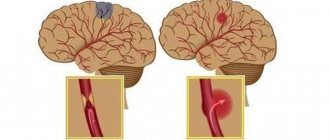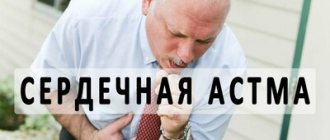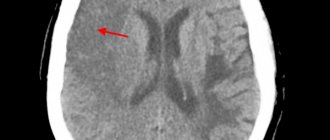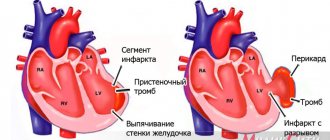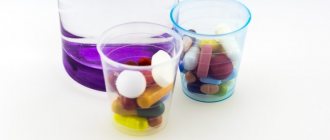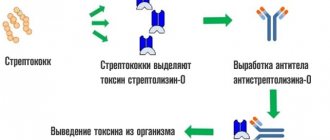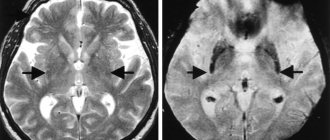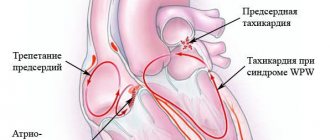If you know exactly the signs of stroke in men, you can avoid serious complications leading to disability and death. A cerebral stroke (CBI) occurs due to impaired blood supply. The attack is facilitated by narrowing of the lumen in the arteries or rupture of blood vessels, resulting in hemorrhage.
The first signs of stroke in men
The general symptoms and first signs of stroke in men are practically no different from the warning signs in women, but the stronger sex is more likely to exhibit motor activity disorders, which is typical for brain diseases.
What to pay attention to:
- Feeling of weakness in the upper and lower extremities, often unilateral. For example, when raising hands, one of the parties “doesn’t listen well.”
- Migraine-like pain syndrome. It is impossible to get rid of pain with painkillers.
- Vomiting is cerebral, with no feeling of relief.
- Increased salivation.
- Difficulty in speech pronunciation due to decreased sensitivity of the tongue.
- Discomfort when swallowing, as contractility in the muscular system of the oropharynx and throat weakens.
- Impaired coordination of movements - it is impossible to perform precise movements, especially when walking (the gait becomes unsteady).
- Disorientation in space and time - the patient does not recognize familiar objects, people, etc.
- Double vision is the inability to focus your gaze. The mobility of one of the eyeballs is difficult, so from the outside the gaze seems lifeless.
- Involuntary urination and cramps - in severe cases of the disease.
- Fear of light and loud noises. A person reacts inappropriately to a switched-on lamp and music (knock, thunder, etc.).
- Loss of strength, drowsiness, general weakness. The patient gets tired quickly, sleeps restlessly, and feels constantly tired.
Symptoms of stroke in men are divided into 2 groups:
- General cerebral: intense localized pain that occurs suddenly. Drowsiness and convulsions, nausea and gag reflexes, pale face and fainting, cyanosis of the skin.
- Focal: occur after general cerebral ones in 15-20 hours. They manifest themselves as numbness of the extremities, decreased sensitivity of the skin in areas of the body that are under the control of the affected part of the brain (BM). Further, visual and hearing acuity is impaired, pupils dilate, eyelids droop, memory is partially lost, and sweating increases. Feature: if hypotension is present, blood pressure drops, if hypertension is present, it increases.
Expert opinion
Author: Daria Olegovna Gromova
Neurologist
The danger of a stroke is the high risk of death. In addition, impaired cerebral circulation leads to serious complications. According to the Federal State Statistics Service, stroke ranks second in the structure of mortality. The disease causes disability. Depending on the severity of the lesion, in 60-70% of cases patients are assigned a disability group. The ability to self-service is lost in 10-15%. Stroke occurs at the same rate in men as in women. Cerebrovascular accidents are most often recorded between the ages of 40 and 65 years. However, recently doctors have been identifying the onset of the disease at an earlier age.
Diagnosis of stroke at the Yusupov Hospital is carried out using modern medical equipment. With the help of CT and MRI, it is possible to determine the type of disorder, its location and extent of prevalence. In accordance with the data obtained, the correct therapy is selected. With timely initiation of treatment, complete restoration of lost functions is possible. An individual rehabilitation complex is developed for each patient at the Yusupov Hospital. It includes not only medications, but also exercise therapy and physiotherapy.
Treatment and rehabilitation
First aid
If you detect the first signs of a stroke, you should immediately call an ambulance (112 - from a mobile phone, 03 - from a landline).
Next, do the following:
1. The patient's head should be elevated. Lay him on the bed and place pillows under his head, shoulders, and upper back; 2. Open the window to allow fresh air; 3. Unbutton all tight clothing: shirt, belt, tie; 4. Measure your blood pressure; 5. If the patient is vomiting, turn your head to the side - the vomit should not enter the respiratory tract.
No medications should be given until doctors arrive. If the patient has lost consciousness and fallen into a coma, artificial respiration and chest compressions must be performed. In a difficult situation, continue to fight for the life of the victim until the end - there is a chance of salvation. People who suffered severe attacks were saved even in the most difficult cases. Remember that only medical professionals can confirm death. Help the patient and wait for the ambulance.
Treatment in hospital
After arriving at the hospital, the patient is sent to the neurovascular department of the hospital, where he undergoes therapy. The patient must normalize blood pressure, prevent swelling and hypoxia of the brain, restore healthy brain function, normalize blood counts and prevent disability.
An elderly person who has survived a stroke needs constant medical care and care from loved ones. Measures are taken depending on the type of stroke:
• Ischemic: reperfusion treatment. Medications are used along with mechanical treatments to restore healthy blood flow in the blocked vessel. • Hemorrhagic: treated with hemostatic agents that lower blood pressure. In case of major hemorrhage, surgery is performed. Surgery can remove blood clots and reduce hematoma.
In the treatment of stroke in the elderly, drugs are used to lower blood pressure, normalize cholesterol, fight blood clots, improve heart function and circulation, antidepressants and sedatives. Medicines are prescribed depending on the individual situation of the patient.
An elderly patient may be prescribed intra-arterial thrombolysis, and endovascular treatment methods are also used. At the beginning of therapy, antiplatelet agents are used. In the first hours after the onset of a stroke, the patient is given aspirin.
After the first treatment, the patient expects long-term rehabilitation and care. Care for the patient depends on his condition. Bed rest and regular skin hygiene by wiping are recommended to everyone. The bed in the head area should be higher, and you should also change your body position regularly (every 2-3 hours) - this is the prevention of bedsores.
A neurologist treats strokes. It helps restore lost physical and mental functions, and also prevents recurrent attacks.
During rehabilitation, various exercises and techniques are used to restore a person’s speech and motor activity. Teachers and psychologists work with the patient to help him return to the social environment. The person is prescribed medication, nutritional therapy, and physical procedures. It is important to follow a healthy diet: eat boiled or steamed food, limit yourself to sweets, salty, fatty foods. You need to give up alcohol and tobacco.
The effectiveness of restoring lost functions will depend on the size and location of the affected area, the general health of the patient, the participation and assistance of loved ones, and the quality of rehabilitation. It is better to begin recovery a week after the stroke, when the patient’s condition becomes stable.
Rehabilitation lasts from several months to several years. Much depends on the patient’s condition and the quality of rehabilitation. Motor activity may return within six months, speech within 2-3 years. With a high-quality integrated approach, the patient will recover faster.
Rehabilitation: highlights
Rehabilitation after a stroke can be divided into several areas of recovery: speech, motor functions, swallowing and bowel function, memory, vision and facial symmetry.
Speech restoration occurs with the help of special exercises that must be performed regularly. A speech therapist works with the patient. A person is taught to pronounce simple words and phrases, communicate with him by asking easy questions, and learn to understand speech. It is also important to train the muscles of the face and tongue, and develop facial expressions. Next, a person is taught reading and writing. If speech cannot be restored, a person learns to communicate using facial expressions and gestures.
To restore memory, they use short texts to memorize, recall incidents from life, communicate on light topics, use finger games and mental games (for associations, invention, logical connections).
Physical therapy is used to restore movement. Use exercises to flex, rotate and move the limbs. They should be done slowly, gradually increasing the load. There should be no pain or discomfort. They also do exercises for the eyes.
In order for the face to become symmetrical again, it is necessary to restore healthy muscle tone and normal shape. To do this, use special exercises for the facial muscles: smiling, winking, jaw movements.
To restore swallowing, the patient is fed light and tasty foods that are easy to chew and swallow. He also does gymnastics for the tongue and lips.
After a stroke, a person spends a long time in a lying position, and this negatively affects the condition of his intestines. To maintain or restore healthy bowel function, he is prescribed laxatives and enemas, as well as a diet rich in fiber.
After an attack, a person may partially or completely lose vision. To prevent blindness, they do special eye exercises, use medications, or perform surgery.
For recovery, a therapeutic massage may be prescribed: it will help to quickly establish healthy physical activity.
Additional Treatments
In addition to the main methods of treatment and rehabilitation, additional methods are used. Let's take a closer look at them.
• Botox therapy. The muscles of people who have suffered a stroke are in tense tone. To relax them, various techniques are used, including Botox therapy. Botox injections help relieve muscle tension. • Exercise therapy – helps restore limb mobility. • Therapeutic massage will improve blood circulation, help cope with spasms, and improve the functioning of the nervous system. • Physiotherapeutic methods relieve pain, restore healthy blood flow, and improve organ function. They use different techniques – both individually and in combination. Vibromassage, electrical stimulation of muscles, electrophoresis, and laser therapy are popular. • Kinesthetics. The patient gradually learns to make movements that do not cause pain. This allows him to move without an assistant - for example, to turn independently in bed. • Reflexotherapy – impact on biologically active points using needles. Acupuncture helps relieve muscle tension, improve the condition of the musculoskeletal system, and establish healthy functioning of the nervous system. • Bobath therapy – teaches healthy areas of the brain to perform duties instead of damaged ones. The entire therapeutic process is under the supervision of a doctor. • Psychotherapy. A person who has experienced a stroke needs psychotherapeutic help and support. It will help cope with depression and psychological problems. This will support the patient's mental health and brain health, which is very important for successful recovery. • Occupational therapy – helps a person return to normal life and restore ability to work.
Folk remedies for recovery
Folk remedies are good helpers during the rehabilitation period. They cannot replace traditional medications, nor can they be self-prescribed. A suitable folk recipe, agreed upon with the attending physician and used as an addition to the main methods of treatment, will help the elderly patient in recovery.
For people who have suffered a stroke, recipes based on black radish, aloe juice, bay leaf, horse chestnut, hawthorn, rose hips and other herbs are suitable. Herbal infusions are popular.
Precursors of stroke in men
The first symptoms of a stroke in men may be mild, so the patient does not always realize the danger of the condition. The appearance of alarm bells does not last long, but between exacerbations the period of remission is also short-lived. To recognize the approach of an attack, it is necessary to pay attention to the precursors of the disease, which have characteristic differences:
- frequent dizziness and pain at the site of the outbreak;
- squeezing sensation in the chest area;
- nausea, gag reflexes;
- sudden mood swings, causeless psycho-emotional disorders;
- facial redness due to hot flashes;
- tinnitus;
- rapid breathing;
- sharp pain in the back of the head;
- insomnia;
- fast fatiguability;
- shortness of breath during movement and at rest;
- absent-mindedness.
If such signals persist for several days, you should seek help from the hospital. You can undergo an examination in Moscow at the Yusupov Clinic, where neurologists will carry out diagnostics using modern equipment and establish an accurate diagnosis even at the initial stage of development of a stroke condition.
Depending on the location of the damage to the cerebral arteries, characteristic symptoms of a stroke appear in a man:
- In the brain stem there is a sudden loss of consciousness, paralysis on both sides, after which the person falls into a coma.
- In the subarachnoid space there are pronounced general cerebral signals.
- In the cerebellum - intense pain in the back of the head, severe nausea and vomiting. Feature: the patient cannot take a vertical position.
- In the ventricles - the disease is accompanied by fainting.
- In the parietal lobe, acquired skills are lost, tactile sensations are disrupted, and spatial disorientation occurs.
- In the temporal lobe - the patient does not recognize familiar sounds and does not understand native speech. The pathology is accompanied by hallucinations.
- In the frontal lobe, causeless aggression or, conversely, depression and convulsions appear.
Diagnostics
How to diagnose a stroke at home
Every person needs to know the signs of a stroke. Being able to recognize a dangerous condition in a loved one in time means saving his life and preserving his health. Remember that anyone can have a stroke.
A stroke affects the nerves of the head and nearby limbs, causing muscles to lose healthy functionality.
Hemorrhagic stroke manifests itself sharply and clearly. You can recognize a dangerous condition by doing a few simple tests:
1. Ask to smile. Normally, both sides of the face are symmetrical, and smiling is effortless. A sick person will not be able to smile straightly; one side of the face will sag and be “late.” 2. Ask to raise both hands and hold them in front of you for a few seconds. A healthy person will be able to raise both arms at the same time, and they will be at the same level. With a stroke, one arm will lag behind the other, or it will not be possible to raise it at all. 3. Ask to repeat a simple phrase. A healthy person will be able to do this, speech will be clear and understandable. The patient's speech is slurred, incomprehensible, and it is difficult to pronounce words. 4. Ask to stick out your tongue - it will tilt to the side. 5. Ask to bare your teeth. You can bare your teeth with only one half of your mouth. 6. Ask to frown. One eyebrow will be furrowed more than the other.
If a person fails these tests, he may be suspected of having a stroke. Call an ambulance immediately.
Ischemic stroke can be detected at home by hypertensive crises and ischemic attacks. This results in a lack of blood supply to the brain. For diagnosis, you can use L. S. Manvelov’s questionnaire. Each “yes” answer receives a point if the symptom has been observed at least once a week over the past 3 months:
1. Headache due to overwork and changes in weather. It is not associated with hypertension, the nature of the pain is non-localized; 2. Tinnitus – regular or periodic; 3. Short loss of consciousness and dizziness when moving (getting out of bed/chair, bending over); 4. Short-term memory loss; 5. Lethargy, insomnia, decreased performance.
If a person answered yes to two or more points, it can be assumed that a stroke will develop in the near future. You need to go to an appointment with a therapist and get a referral to a neurologist from him.
Diagnostics in the hospital
To determine the type of stroke, different techniques are used: magnetic resonance imaging, computed tomography, electroencephalography, head X-ray, cerebrospinal fluid examination and blood tests.
The data obtained helps determine the type of stroke, the location of the pathology, and discover connections with parts of the brain. The sooner the patient is taken to the hospital, the more accurate his examination will be and the more effective the assistance. In the first 6 hours after an attack, medical care is most effective. This is especially important in acute strokes, which can severely damage the brain within 3-5 days.
Risk factors for stroke in men
Blood circulation in the brain is disrupted due to negative factors. The causes of stroke in men do not differ from the etiology of the disease in women, but the most common factors are bad habits. What can cause brain damage in the stronger sex:
- frequent consumption of alcoholic beverages;
- long-term smoking;
- taking narcotic drugs;
- obesity due to diabetes and poor nutrition;
- physical inactivity - a sedentary lifestyle;
- doing strenuous sports;
- backbreaking physical labor;
- taking certain groups of drugs;
- constant overheating of the body (in the sun, in a hot workshop, etc.);
- pathological changes due to age;
- genetic predisposition;
- frequent stress, nervous strain;
- blockage of blood vessels due to diseases of the cardiovascular system (atherosclerosis, arterial hypertension, thrombosis, thrombophlebitis, arrhythmia, ischemia, heart failure, vasculitis, etc.);
- hormonal imbalance due to thyroid diseases, diabetes;
- migraine;
- intoxication of the body;
- infectious diseases.
Representatives of the stronger half of humanity tolerate the pathological condition more easily than women. It takes less time for the body to recover. This is due to physical fitness and the lack of a tendency to frequent psycho-emotional disorders. The consequences of a stroke in men can be severe, depending on the course of the disease and the timeliness of contacting the clinic.
Prevention
Preventive measures should be regularly observed by all elderly people over 60 years of age.
1. Regularly undergo a comprehensive examination of the body. In old age, regular examinations are especially important if a person has frequent headaches, dizziness, fainting, hypertension and arrhythmia, elevated cholesterol levels, a traumatic brain injury, or problems with vision, hearing, sleep, attention and memory. 2. Adhere to healthy lifestyle standards. It is especially important to eat right and give up bad habits. 3. Monitor blood pressure and glucose levels and maintain these indicators within normal limits. 4. Do physical therapy. A specialist will help you choose the appropriate exercises individually for the person. 5. Avoid excessive stress, maintain a calm emotional background. 6. Treat chronic diseases.
Remember the main signs of a stroke and how to check for it. Be attentive to the health of a loved one and immediately call an ambulance if you suspect a stroke - time is very important. Provide first aid and then assist the victim in recovery. If your loved one is healthy, teach them about stroke prevention. Correct actions will help protect yourself from a dangerous disease.
Ischemic and hemorrhagic stroke
IGM is divided into two main types depending on the cause of its occurrence:
- The ischemic form is considered less dangerous, as it differs in the duration of development, which allows timely detection of abnormalities in the cerebral blood supply. The root cause is blockage by a blood clot, narrowing of the lumen in the arteries, resulting in a deficiency of oxygen and nutrients, since the blood does not circulate in a normal rhythm.
- The hemorrhagic type is the most dangerous, as it occurs unexpectedly and occurs in an acute form. It develops most often against the background of pathological disorders, which leads to rupture of cerebral arteries and hemorrhage. Another name is apoplexy, before which blood pressure rises sharply. During a rupture, the cranial cavity is filled with blood fluid, which contributes to the formation of hematomas. The severity of symptoms depends on the type of rupture - extensive or small-focal.
The treatment method is selected based on the type of disease, which is determined during diagnostic procedures. At the Yusupov Hospital, doctors conduct a comprehensive examination, which allows them to identify the severity, form, and period of development of the pathology, on the basis of which individual therapy is prescribed and a preliminary prognosis is built.
The first symptoms of ischemic stroke in men
Ischemic damage in the stronger sex is more often diagnosed after the age of 40, especially with such abnormalities as atherosclerosis and thrombosis that occur against the background of an unhealthy lifestyle. It occurs in the following forms:
- The subacute form is characterized by a gradual increase in symptoms, since blood circulation is not completely impaired. An attack can occur within a few hours or days (maximum 3-4).
- The acute type is characterized by rapid and pronounced symptoms. During an impact, the blood supply stops, which causes tissue death in parts of the brain (necrosis). Differs in extensive foci.
- Chronic form - from the beginning of the appearance of alarm signals to the attack, 2 or more months pass. The nature of the symptoms up to exacerbation is moderate.
- The course of a stepwise type is characterized by frequent changes of remission and exacerbation. The impact is possible after 2 weeks.
At an early stage of the disease, dizziness, chest pain, loss of strength, weakness, and stupor are noted. Next, the patient exhibits the following:
- nausea and vomiting;
- difficulty swallowing;
- epileptic seizures;
- partial memory loss;
- fainting;
- paresis in the muscular system of the tongue and face (usually on one side);
- impaired coordination of movements - gait changes, stability decreases;
- loss of orientation in space;
- increased sweating;
- lack of air;
- numbness in the upper and lower extremities;
- paralysis of one or both sides;
- inability to fully pronounce words;
- a sharp decrease in visual acuity;
- difficulties with reading, counting, writing words;
- progression of memory loss.
Usually one side of the body is affected: if damage to the arteries occurs on the left, then numbness and curvature are observed on the right side and vice versa.
The first signs of hemorrhagic stroke in men
When blood vessels rupture, brain cells are destroyed and the trunk is damaged. This leads to increased pressure on internal organs - the visual apparatus, heart, central nervous system. As a result, swelling of the brain occurs, displacement of parts of the central nervous system, therefore, in the hemorrhagic form, neurological symptoms appear.
What's happening:
- Immediately before the attack, you feel very dizzy, the pain increases rapidly. Then the limbs go numb, blood pressure rises, the face and neck turn red, weakness and severe nausea are felt.
- As it progresses, the smile becomes bent, the tongue spontaneously turns to one side, and speech function is slightly impaired.
- While the patient is conscious, a fear of light and sounds develops, there is no coherence of speech (it becomes impossible to formulate a thought, pronounce a whole sentence, letters “fall out” of words). Floaters flash before your eyes and an epileptic seizure begins.
- After this, the person faints, does not react to light, and the face becomes distorted and asymmetrical. If you open his eyes slightly, you can notice the floating state of the apples, the resulting squint.
- In an unconscious state, the patient's blood pressure drops sharply, the pulse and heart rate slow down.
- When hemorrhage begins, neurological signals increase - motor activity is partially reduced or completely lost, muscle tone weakens. When examining the eyes, a significant dilation of the pupils is noticeable. The corners of the lips droop, which smooths out the nasolabial triangle.
- A period of stupor sets in, during which the person falls into deep sleep, so there are practically no reactions.
- If there is no action, a representative of the strong half of humanity falls into a coma, which is dangerously fatal.
Ischemic or hemorrhagic stroke - how to distinguish?
To independently (before the doctors arrive) determine the type of stroke condition, pay attention to the main distinguishing features:
| Manifestations | Ischemic injury with impaired blood supply | Hemorrhagic lesion with rupture of arteries |
| Level of increase in symptoms | Smooth | Intensive |
| Features of the beginning of the strike | Weakly expressed | Sudden |
| Filling of the retina with blood | Never | Always with large tears |
| Arterial pressure | Decreasing | Increasing |
| Loss of consciousness, fainting | Short term | Long-term |
| Degree of sweat separation | Lightweight | Strong |
| Dry mouth | No | Eat |
| Pain in the chest and head | Minor | High, sharp |
| Nausea and vomiting | Nausea, but vomiting is manifested only by reflexes | Severe nausea and vomiting |
| Body temperature | Increases in rare cases | Always increases |
Stroke test
There is a test called BE FAST, which is used in medicine to instantly diagnose a stroke attack. The abbreviation has its own meaning:
- B - balance. You need to watch how a person makes movements. Poor balance indicates an impending blow.
- E - eyes. Check the level of visual acuity - have the patient alternately close/open his eyes and tell what he sees in front of him.
- F - face. Ask to smile and stick out your tongue. During an attack, curvature occurs in one direction.
- A - arms. Have the victim raise both arms or shake their palms - one of the limbs will be weaker or will not rise.
- S - speech. Talk to the victim - if there is a lack of cerebral blood supply, speech is impaired.
- T - time. The patient denies the disorder.
If you discover at least one type of deviation, immediately contact the Yusupov Clinic, where experienced doctors will provide primary medical care, establish an accurate diagnosis, and prescribe therapeutic measures. For this purpose, innovative medical technologies of the European level, powerful equipment, and an individual approach are used. You can ask questions and get tested by calling the numbers provided.
